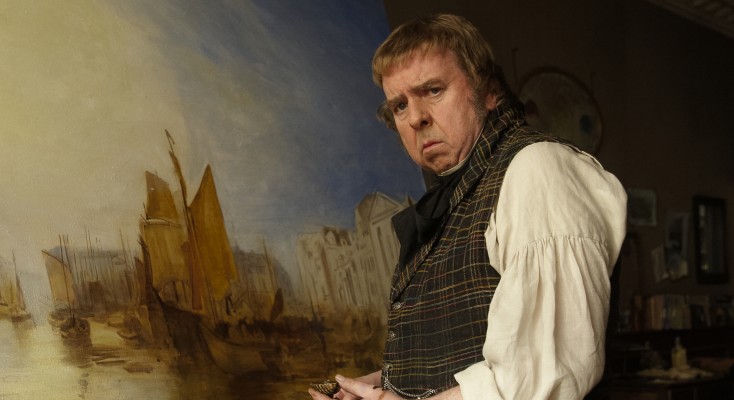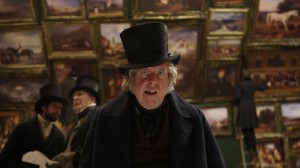By ANGELA DAWSON
Front Row Features
HOLLYWOOD—British actor Timothy Spall is getting some of best notices of his career with his performance as the enigmatic 19th century British artist J.M.W. Turner in Mike Leigh’s “Mr. Turner.” Already this year, he has been acknowledged as best actor at the Cannes Film Festival and he has topped the list of various film critics’ organizations for his remarkable portrait of a man who was gifted and prolific and yet who could be difficult and distant to those closest to him.
The 57-year-old London native recently discussed his latest collaboration with Leigh, whom he has known for more than three decades and has worked with previously six times. Part of his preparation for the role involved taking painting lessons for a few years so the scenes in which his character is applying brush to canvas appear authentic.
Having starred in Leigh’s “Secrets and Lies,” “Topsy-Turvy” and “All or Nothing,” among other works, he acknowledges an unspoken shorthand with the renowned writer-director.
While his onscreen character frequently lacks the ability to verbalize his ideas with those around him, Spall, a married father of three, displays a gift for gab while discussing the his long association with Leigh, taking on a talented but flawed artist and how he dealt with a near-fatal disease.[private]
Q: When you look back on this project, how do you feel about it?
Spall: It was a great journey to go on. It was a long haul. What was great about it was working with Mike for the seventh time. This is the culmination of a 33-year relationship. For him to have asked me to do this in the first place was great. I knew it wasn’t going to be a conventional journey.
Q: How challenging was it and how did you prepare?
Spall: Mike doesn’t mind people talking about the way he works because he has a modus operandi and formula that he has invented, which is the work is made up. You start with nothing, and he’s very blatant about that. He says, “Here we are together. In a year, we’ll have a film.” This is his second biographical piece. What he does is he uses this technique whereby you come to the character through improvisation. You create a proto human being out of people you’ve encountered in your life, and you start building this person and you start becoming this person.
You try to make this person reach towards the research that you’re discovering about the character of Turner. I spent a lot of time reading, discovering, observing and going through the work, looking at the extant material—the eyewitness accounts of what he looked like and what he spoke about. You’re trying to build this human being that will fit the bill. You try to bring this character together and let the research match it and create this person that is the sum total of all that endeavor. What you do is create this whole parallel universe, really, in which you start becoming Turner World, and you start living real time in this world. It’s an organic process.
Q: Can you talk about learning to paint for this role?
Spall: Mike told me we were going to make a Turner film in 2010. He said he didn’t know where the money was going to come from or what the film would be about, except that it was going to be about Turner. He said, “Don’t get excited,” because it’s three years out. He said, “Why don’t you go and learn to paint for a couple of years?” So I did. So in-between jobs, I’d go to Tim Wright, a very talented portraitist and teacher, and learn. Basically, he gave me a sort of personal fine-art foundation. We did all the elements and eventually he guided me toward how Turner works. That culminated in me attempting a couple of copies. I ended up painting “Snowstorm: Steamboat off a Harbor’s Mouth,” which I’ve got on my wall at home. I look at it and think, “How the **** did I do that?” I certainly couldn’t do it again. But as the old saying goes, “Nothing concentrates the mind like the prospect of being hanged at dawn.”
Q: Turner has some odd mannerisms and he sometimes simply grunts instead of speaking to people. Can you talk about getting that specific movement and sound of the character?
Spall: We looked at pictures and we read descriptions of what he looked like. He had this certain hunched quality and he had this explosive nature. We worked on that right from the beginning. The film is about the last 25 years of his life, so we show him with his odd swagger that grows into this even more odd position. He was a person who was almost implosive in his nature and implosive in his body. The explosiveness is expressed through his art.
Q: Did this come journals of people who knew him or was this yours and Mike Leigh’s ideas?
Spall: Both. There are reports about how he spoke and how he was and they’re wonderfully contradictory, as are all the different portraits of him. Considering he was knocking about with some of the most famous portrait painters in the world, he didn’t like being painted. He didn’t like people knowing much about him at all. He was incredibly secretive and he was incredibly determined that people would never know much about his private life. Nobody knew that he had children.
I read almost everything that was written about him. There are times where he is very expressive and he speaks a lot more than people actually realize, but he speaks in a very colorful tone. People come away from it that he only communicates with grunts. I know he speaks a lot because I had to learn those lines and speak them. He had a sophisticated baroque way of talking.
The way he expressed himself was hard to understand and there are reports where one time he would be very expressive as he is in the academy. He’s very convivial and very open and sociable. But there also are reports where he people would ask him questions and he wouldn’t respond. When Delacroix for example, the great French artist, showed him around his studio, Turner would look at him and just say, “Mmm… fine… mmm…. yeah.” And then he left. Delacroix said, “Who the **** was that? Is that the great Turner?” So it was little things like that.
Q: There is a scene in the film where Turner is with a prostitute sketching her and he begins to cry quite mournfully. Why does he express such emotion at that time?
Spall: What happens in that scene is he’s using her as he uses a lot of people—as a subject. I think he catches himself looking at her and when she says how young she is, he sees everything in his life, everything emotional, and the lid just shoots off like a pressure cooker. He can’t keep the lid on for that minute. It’s like this massive ectoplasmic gleaming of sorrow comes out of him. It shoots out of him like a volcano of emotion and despair. It’s just something he can’t hold in. Eventually, he puts it back in and he carries on. It grew organically out of an improvisation Mike had me do but a lot of people don’t understand it. I think that it’s quite good because in a sense it’s supposed to be odd and unexplained. I don’t want to say anything more about it because I’m getting a little bit upset thinking about it.
Q: You were diagnosed with acute myeloid leukemia nearly a decade ago, but you were successfully treated and are now in remission. How did that experience affect you?
Spall: Having a scrape with your own mortality is not something you would choose to have, obviously. But when you find yourself in that situation, you throw yourself upon the trust of Providence. What gets you through these things is a profound mixture of love and expertise. The expertise comes from the people who are clever enough to stop you dying from leukemia and the love comes from good will and your desire to get over something because there are people you love.
As with all terrible things—and I know this sounds cliche— but what doesn’t kill you makes your stronger. It makes your center softer but I also think it’s always in there and it will always be there forever. What happens to you when you are getting better after a near-death experience is you spend the time enjoying the very simple things in life. Looking at a tree can be enough. Watching a child play can be enough. Looking in a child’s eye can be enough. But that’s profundity. You can’t live your life living in a state of profundity; otherwise you won’t get anything done. You’re Tim the Profound. (He laughs.) You’re a bloody bore. What happens is you start getting petty again, but that’s life. Life is not all about profundity. Life is about little triumphs and little defeats. Once you start being petty again you know you’re alive.[/private]






